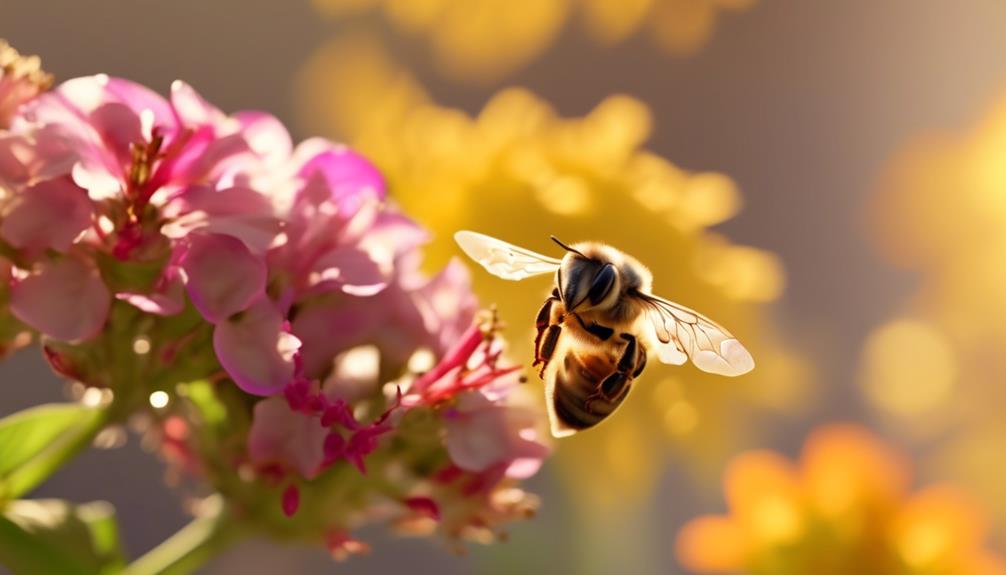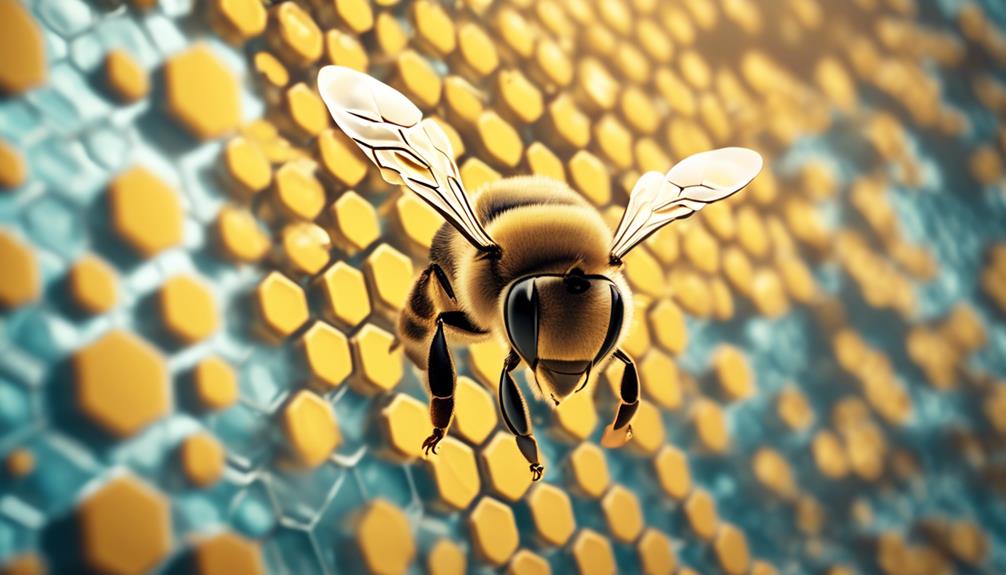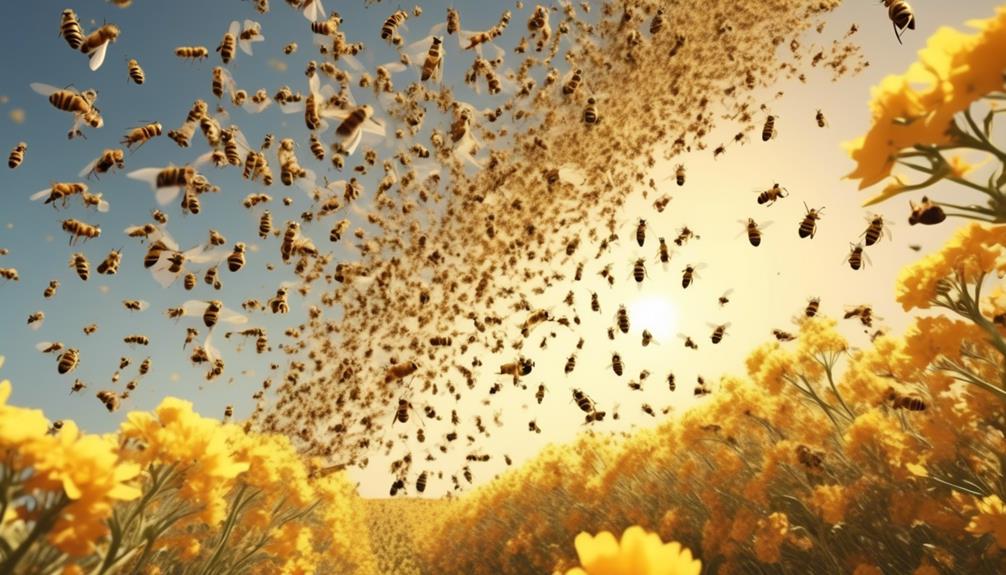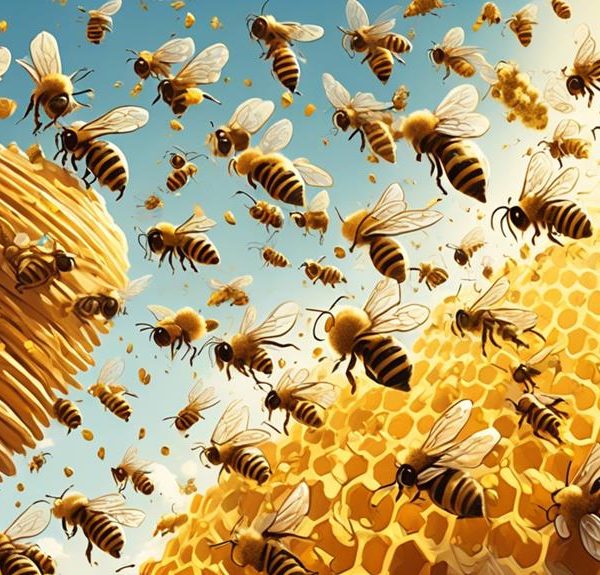Keen to discover if bees can fly backwards? Uncover the fascinating secrets of their flight patterns and their impact on aviation and robotics.

Can Bees Fly Backwards?
Just like Icarus in the ancient Greek myth, bees too seem to defy the odds with their flight. However, you may be wondering if these tiny creatures are capable of more complex maneuvers such as flying backwards.
Well, it's a fascinating subject and one you've probably never considered. Imagine being able to move in reverse without having to turn around, it's something beyond our human capabilities.
This peculiar behavior of bees not only challenges our understanding of their flight mechanics but also opens up a new realm of possibilities in the world of aviation and robotics.
So, are you ready to explore the intriguing world of bees and their flight patterns?
Key Takeaways
- Bees have a unique flight mode that allows them to fly backwards and hover.
- Bees rely on visual information, sun position, and memorized landmarks to navigate, but rely more on spatial memory and their internal compass when flying backwards.
- Bees adopt a specific posture with pitched bodies and extended hind legs when flying backwards.
- Bees' ability to fly backwards is crucial for efficient unloading and distribution of nectar or pollen, as well as for communication through the waggle dance.
Understanding Bees' Flight Mechanics

To truly grasp the concept of bees flying backwards, you must first delve into the intricate mechanics of a bee's flight. To start with, bees have two pairs of wings, the hind and fore wings. In flight, these wings hook together to form a single surface. But it's not just their wings that make them unique. Bees' bodies are specially built for flight, with a lightweight exoskeleton and strong muscles to power their wings.
Now, let's get technical. The bee's wing flap follows an elliptical pattern, moving forward and down, then backward and up. This motion creates lift, enabling the bee to stay aloft. But it's the angle of the wings that's key. When a bee wants to fly forward, it angles its wings slightly back. To fly backwards, it does the reverse, angling its wings slightly forward.
Understanding this, you might think it's a piece of cake for a bee to fly backwards. However, it's not as easy as it sounds. Bees can't see directly behind them, so they rely on their peripheral vision and sense of touch to navigate. Remember, bees aren't built like helicopters. Backward flight takes hard work and skill.
The Science Behind Bees' Navigation

Now that you've got the basics of bees' flight mechanics, let's dig deeper into how they navigate, particularly when flying backwards. Bees use a complex navigation system that combines visual information, sun position, and memorized landmarks. When flying backwards, they must rely more heavily on spatial memory and their internal compass.
For a bee to successfully fly backwards and reach its destination, it must first create a detailed spatial map of its surroundings. This is done by performing a series of 'learning flights' where the bee gathers visual information about the environment. It's a unique process that requires a high level of spatial awareness and cognitive functioning.
Here's where it gets really interesting: bees use the position of the sun as a compass. Even on cloudy days, bees can detect the polarization of light, which helps them know the sun's position. They're also known to use memorized landmarks to guide their route.
Instances of Reverse Flight in Bees

Delving into the impressive realm of reverse flight in bees, you'll find that it's not a common occurrence, but rather a skillful maneuver they resort to in specific situations, typically during the process of unloading heavy nectar or pollen. It's a fascinating spectacle of nature in action, a testament to the bees' exceptional athleticism and adaptability.
Scientifically speaking, bees demonstrate this backward flight while landing or dismounting from flowers. They do so to maintain balance and stability. It's a complex process that involves a host of sensory and motor tasks, requiring them to adjust their speed, angle, and flight path accordingly.
Researchers have used high-speed cameras to capture and analyze these instances of reverse flight. The videos revealed that bees, when flying backwards, adopt a specific posture. Their bodies are pitched upwards, wings beating rapidly, and their hind legs extended to counterbalance the weight of the pollen or nectar they're carrying.
This reverse flight isn't simply a spectacle; it's an important survival skill. It allows bees to efficiently unload and distribute nectar or pollen, ensuring the survival of the hive. So next time you're watching bees, look out for this extraordinary display of aerobatics.
Comparing Bees' Flight to Other Insects

When you compare the flight patterns of bees with other insects, you'll notice a distinct difference in their agility, speed, and adaptability. Unlike other insects, bees have a unique flight mode that allows them to fly backwards as well as hover in mid-air. This is quite remarkable given their size and wing structure.
Consider the dragonfly, for example. They're quick, agile, and can dart in different directions, but they can't fly backwards. Similarly, butterflies boast a slow, fluttering flight and they too lack the ability to reverse in air.
You'll find that bees' flight speed isn't the fastest, with some insects like the hawk moth surpassing them. However, bees' adaptability and agility in flight are unparalleled. They're capable of adjusting their flight based on environmental conditions and the weight of the nectar they've collected.
The flight mechanics of bees are a marvel of nature. Their wings rotate at high speeds, providing them with the lift needed to carry heavy loads. Such flight adaptations aren't seen in all insects, making bees truly unique in their abilities.
Through this comparison, it's clear bees exhibit distinctive flight patterns that set them apart.
Implications of Bees' Backward Flight

Understanding the implications of bees' unique ability to fly backwards can shed light on their efficiency in pollination and overall role in ecosystems. It's not just a novelty; this skill is integral to their survival and ours.
Imagine you're a bee, and you've just plunged headfirst into a flower. You're covered in pollen. Now, you need to back out without damaging your precious cargo or the delicate petals. Your ability to fly backwards is crucial in this moment. It's a highly efficient maneuver that minimizes energy expenditure and reduces the risk of pollen loss.
Furthermore, bees' backward flight plays a vital role in their communication. They perform the famous 'waggle dance' to inform their hive mates about the location of food sources. Part of this dance involves moving backwards in a straight line, the length of which corresponds to the distance to the food source.
Frequently Asked Questions
What Is the Average Lifespan of a Bee?"
You're curious about the average lifespan of a bee. It's not a simple answer, as it varies by species and role.
Worker honeybees typically live up to six weeks in summer, but can live up to five months during winter.
Queen bees, on the other hand, can live up to five years!
It's fascinating, isn't it? These tiny creatures have such varied lifespans depending on their duties within the hive.
How Do Bees Communicate With Each Other?"
You might be surprised to learn that bees communicate through a series of movements known as 'the waggle dance.'
In this intricate dance, a bee wiggles its body and changes direction to communicate the distance and direction of a food source.
It's fascinating, isn't it?
This form of communication is unique to bees and has been studied extensively by scientists, revealing the complex society within a beehive.
Are There Different Species of Bees That Fly Backwards More Often Than Others?"
Yes, differences in bee species can affect their flying behavior.
For example, honeybees are known to fly backwards during their 'waggle dance' to communicate with others in the hive.
However, it's important to note that all bees have the capability to fly backwards when needed, such as when backing out of a flower.
It isn't necessarily a common occurrence and doesn't indicate that certain species do it more frequently.
What Role Do Bees Play in the Ecosystem?"
Bees play a crucial role in the ecosystem as primary pollinators. In your garden, they're helping to fertilize flowers by transferring pollen between the female and male parts of a plant. This process allows plants to grow and produce food.
Without bees, many of your favorite fruits, nuts, and vegetables wouldn't exist. So next time you see a bee buzzing around, remember they're not just there for their honey, they're vital for our ecosystem.
How Does Climate Change or Pollution Affect the Flying Abilities of Bees?"
Yes, climate change and pollution can indeed affect bees' flying abilities.
For instance, certain pesticides can impair their navigation skills, causing them to lose their way back to the hive.
Moreover, higher temperatures due to global warming can overheat their bodies, hindering their flight performance.
It's not just about whether bees can fly backwards, but their overall ability to survive and pollinate, which is crucial for our ecosystem.
Conclusion
So, can bees fly backwards? Absolutely! This impressive feat, unique to these extraordinary insects, is part of their complex flight mechanics. It's a crucial aspect of their navigation process, especially when retreating from a flower.
Other insects pale in comparison to bees' backward flight capabilities. Understanding this unusual behavior not only expands our knowledge of bees but also has potential implications for improving drone technology.
Bees, it seems, still have much to teach us.



